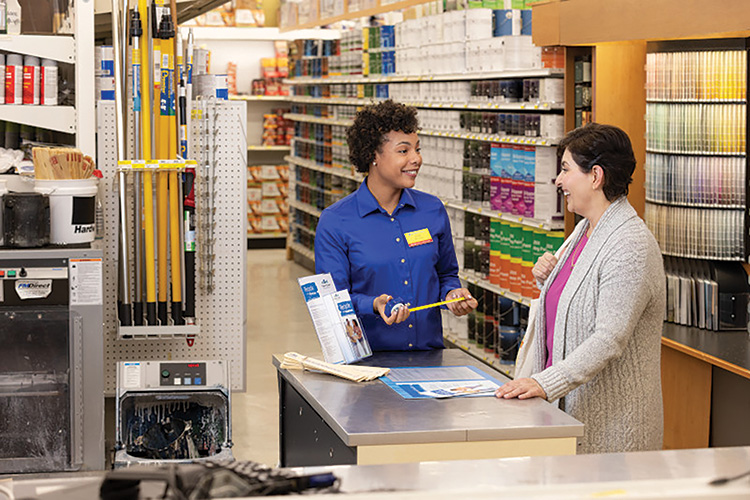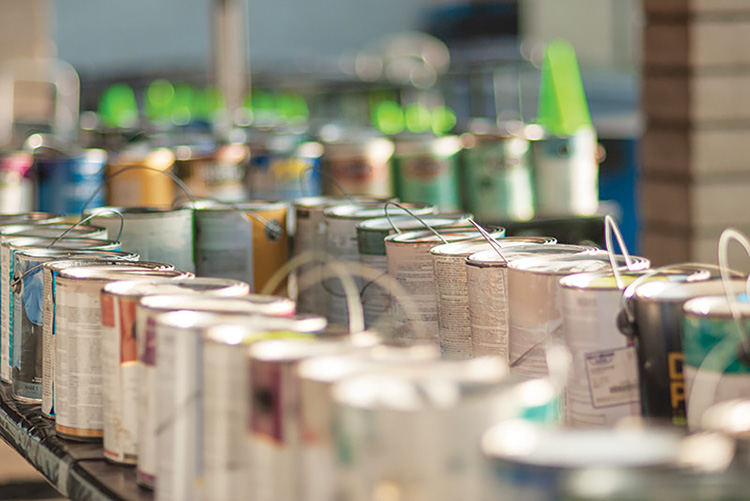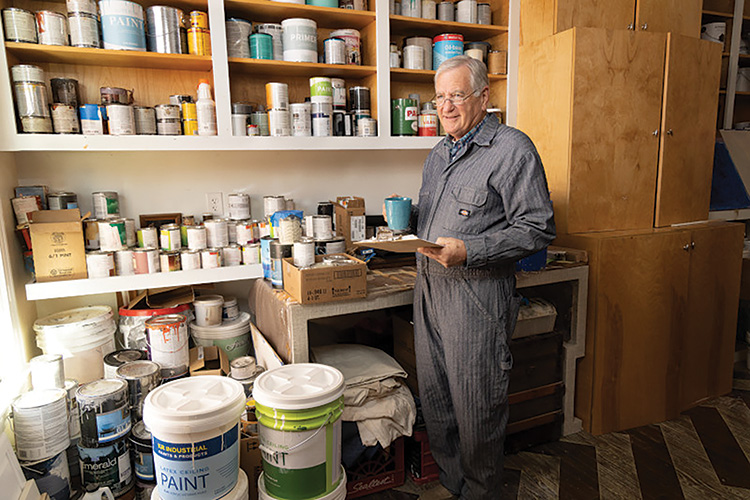Expanding paint ERP can help shift the cost burden from municipal HHW facilities, while keeping them involved as an important partner in paint recycling efforts. As an industry-led product responsibility organization, PaintCare is a key player in the circular economy for paint.
By Callie Yow
Welcome to NAHMMA Corner! A majority of NAHMMA’s members operate municipal household hazardous waste (HHW) collection facilities, and one of the most common questions they field from residents and businesses is “What can I do with all this leftover paint?” For more than a quarter of residents in the U.S., their state has passed extended producer responsibility (EPR) laws for paint. PaintCare, a non-profit organization, and NAHMMA partner, was created by the American Coatings Association (ACA) and operates in the states that have passed paint stewardship laws: California, Colorado, Connecticut, Maine, Minnesota, New York, Oregon, Rhode Island, Vermont, and Washington, as well as the District of Columbia, and is planning a program for Illinois.

Introduction to PaintCare
As an industry-led product responsibility organization (PRO), PaintCare is a key player in the circular economy for paint. This non-profit organization enables consumers to easily drop off leftover paint at conveniently located sites and educates the public about reducing paint waste. Collectively, the organization has managed more than 68 million gallons of leftover paint, diverting most of it away from landfill in favor of beneficial reuse and recycling. The program is funded by a nominal “PaintCare fee” placed by manufacturers on every container of architectural paint sold in an active state.
Convenient, Year-Round Access to Paint Recycling
Convenient access to the program is one of the keys to PaintCare’s success. Across the 11 active PaintCare programs, there are approximately 2,500 year-round paint drop-off sites for use by households, businesses such as painting contractors, and others with leftover paint. Most (about 75 percent) of the sites are paint retail stores based in centrally located areas, making it easy for consumers to find them and drop off their paint. PaintCare also works with municipal HHW facilities, solid waste transfer stations, recycling centers, public works departments, and material reuse stores (e.g., Habitat for Humanity Restores) where leftover paint in good condition is resold.
In addition to year-round sites, PaintCare has also managed paint from over 7,000 municipal HHW and paint collection events, conducted more than 8,700 large volume pickups from painting contractors and others with 100 gallons of accumulated paint or more, and held over 300 PaintCare-operated drop-off events in underserved communities. The program is currently collecting approximately 700,000 gallons of leftover paint per month. About three quarters of the collected material consists of latex (water-based) paint and one quarter consists of oil-and solvent-based paint.

Photos courtesy of PaintCare.
Expanding Highest, Best Uses for Paint
Leftover paint collected by the PaintCare program is managed according to the waste hierarchy of highest, best use. This means that paint is reused or recycled by processors back into paint whenever possible. If it cannot be reused or recycled, processors find the next best use for it. Most latex paint is used to manufacture recycled-content paint products, while some is used for concrete mixtures, landscaping materials, or as a component of daily cover for landfill management. A small percentage of dry latex paint is securely disposed of if no other use can be found. Oil and solvent-based products are mostly used by processors as fuel. In some states, a small percentage of oil-based paint is recycled into new paint products.
Outreach and Education Efforts
PaintCare’s public outreach efforts ensure that households and businesses in active states learn about the program and the recycling opportunities it offers. Following the waste management hierarchy of reduce, reuse, recycle, PaintCare’s educational messaging encourages consumers to “buy right, use it up, and recycle the rest.” PaintCare provides a variety of brochures, signage, cards, and other point-of-sale materials to paint retailers and others in each active program state so those purchasing and using paint will have an easy reference when the job is done.
Leading in the Paint Industry
By providing a comprehensive solution for the management of leftover paint, PaintCare has taken significant strides towards a circular paint economy—one gallon at a time. With continued support and expanding initiatives, the program’s role in promoting responsible paint recycling will continue to grow, inspiring other industries to follow suit in adopting stewardship practices.
Paint EPR Fees
All these beneficial activities are funded through a nominal, mandatory EPR fee placed by paint manufacturers on every container of architectural paint sold in active program states. The fee is based on container size and is applied to containers larger than a half pint and up to 5 gallons in size, using three fee tiers. It is set at a level to cover the costs specific to each program and varies by state, though an effort is made to use similar fee structures when possible.
Expanding Reuse Product Access
PaintCare staff are currently exploring new ways to expand paint reuse. In 2022, piloted reuse-focused events during which leftover paint collected by contracted waste haulers were made available for free giveaways to local communities in the cities of Merced and Redlands, CA. These events continued in 2023, expanding into the Oregon PaintCare program. In total, PaintCare facilitated giving away 17,106 gallons of latex paint and 403 gallons of oil-based paint across these events in California and Oregon. The organization plans to expand these events and other similar initiatives to other program states and to offer reuse solutions in as many areas as possible.
PaintCare is interested in exploring other paint reuse options in collaboration with household hazardous waste facilities and programs in existing PaintCare program states. Interested individuals, programs, and agencies can reach out directly to Dan King, National Operations Manager, at [email protected].

Expanding Paint ERP
Collecting and properly managing 700,000 gallons of paint each month for recycling and reuse is no small feat. However, with only a little more than a quarter of the U.S. population currently having access to the PaintCare program, that means millions more gallons of paint are being managed by residents, business, and municipal HHW facilities without the financial support that EPR programs such as PaintCare provide. While many HHW facilities offer swap areas to promote paint reuse, these swap areas are not able to manage the large volume of incoming paint and require the costs of staffing and infrastructure support in addition to costs associated with managing the paint that does not end up in the swap area.
Expanding paint EPR can help shift the cost burden from municipal HHW facilities, while keeping them involved as an important partner in paint recycling efforts. NAHMMA, in partnership with PaintCare, is hosting a webinar on January 18. Sign up at nahmma.org/Webinars. In addition, PaintCare’s Government Affairs Team has resources that can assist grassroots efforts in states without paint EPR. Interested individuals, programs, and agencies can reach out directly to Heidi McAuliffe, Vice President of Government Affairs, at [email protected]. | WA
Callie Yow manages corporate relations at PaintCare, the nonprofit organization that operates paint stewardship programs in 10 states and DC. Prior to joining PaintCare, Callie managed PR and marketing at a global social enterprise and has served as an education and climate science lead with the National Park Service. For more information, visit www.paint.org.
